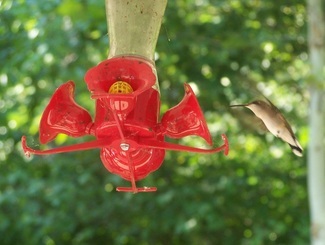My Name is Donna, and I'm a Hummingbirdaholic.��
 I must admit, out of all God’s creatures, my least favorite had always been birds. Probably because my Granny Ison had a coop full of the meanest frickin’ chickens in history. My theory is that her hen house was some portal from hell and those fowl were its demon guardians. I swear their eyes glowed red. They led to a reoccurring nightmare about being mauled by giant chickens. Killer poultry also make an appearance in
The Miracle of Myrtle: Saint Gone Wild.
I must admit, out of all God’s creatures, my least favorite had always been birds. Probably because my Granny Ison had a coop full of the meanest frickin’ chickens in history. My theory is that her hen house was some portal from hell and those fowl were its demon guardians. I swear their eyes glowed red. They led to a reoccurring nightmare about being mauled by giant chickens. Killer poultry also make an appearance in
The Miracle of Myrtle: Saint Gone Wild.
That was until I moved to Bohemian Bay where we have all the cool including blue heron, cormorants, mallards, wood ducks, red-headed woodpeckers, loons, hawks, and hummingbirds. I know this because, after tiring of me making up names like the “Too-Good-to-Talk-to-Me-Even Though-I-Know-It-Can” and “Long-Necked Hateful Duck,” a friend gave me the National Audubon Societies’ Field Guide to Birds.
This summer, I have become obsessed with hummingbirds. I have two feeders that I watch like they are Prince in concert or a Criminal Minds marathon.
Here are some of the facts I’ve learned about the Trochilidae.
Like me after a night of heavy drinking, the hummingbird needs to eat twice its body weight in food every day, and to do so they must visit hundreds of flowers. Hummingbirds are the smallest of all birds.
They get their name from the humming sound their wings make when they flap them, which is normally about 80 times a minute. However, when a male is trying to impress a lady, he can up his game to 200 flaps a minute.
The hummingbird could totally get to the middle of a Tootsie Pop in no time flat. They have a long tongue which they use to lick their food at a rate of up to 13 licks per second.
They can fly right, left, up, down, backwards, and even upside down. They are also able to hover by flapping their wings in a figure-8 pattern.
"Their feet ain't made for walking," sung in the style of Nancy Sinatra. The hummingbird’s feet are used for perching only.The popular southern dessert hummingbird cake does not actually contain hummingbirds. The hummingbird’s favorite colors are red, orange, yellow, or purple like because these are the colors of the flowers they prefer. So, to lure these fascinating little creatures to your home, first get a feeder in one of the hues.
Hummingbirds subsist primarily on insects and nectar. Contrary to popular belief, your nectar should not be colored. Dyes are not necessary, and some can be harmful. Here is a simple recipe:
1 Cup Sugar
4 Cups Water
Bring to a boil, simmer until sugar melts, stirring constantly.
Cool down to room temperature.
Fill your feeder and hang it in a shady spot. Direct sunlight makes the nectar ferment faster. Then, just wait for the winged magic.
And here is the saddest fact of all…hummingbirds are migratory, so come fall we must say good-bye. When the temperature drops, you should take your feeder down, so the precious little things don’t get confused and stay around too long. Farewell, my little feather friends.
Now, I guess I better get to work on my Sasquatch feeder for the winter.
Published on September 03, 2015 05:55
No comments have been added yet.



